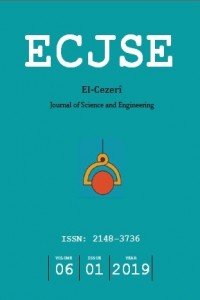Research Article
Year 2019,
Volume: 6 Issue: 1, 193 - 199, 31.01.2019
Abstract
Bu çalışmanın amacı, Al2014 alüminyum alaşımının
kaplamasız sementit karbür takım ile delinmesi sonucunda itme kuvvetinin
deneysel ve simülasyon sonuçlarını kıyaslamaktır. Deneysel çalışmada, farklı
seviyelerde kesme parametreleri (kesme hızı ve ilerleme miktarı) kullanılarak delme
işlemi yapılmıştır. Kesme kuvveti için nümerik analizler, sonlu elemanlar yöntemine
dayalı çözümleme yapan ThirdWave Advantedge simülasyon programıyla
gerçekleştirilmiştir. Çalışma sonucunda, deneysel olarak ölçülen kesme kuvveti
ile simülasyon sonucunda elde edilen kuvvet değerleri arasında ortalama %8’lik
bir fark olduğu belirlenmiş ve sonlu elemanlar modelinin uygulanabilirliği
kanıtlanmıştır.
References
- [1] Prasad SV., Asthana R., “Aluminum metal-matrix composites for automotive applications: tribological considerations”, Tribology Letters, 2004, 17: 445-453.
- [2] Raghubanshi H., Dikio ED., Naidoo EB., “The properties and applications of helical carbon fibers and related materials: a review”, Journal of Industrial and Engineering Chemistry, 2016, 44: 23-42.
- [3] Sandvik Coromant, “Modern Metal Cutting”, Sweden 1994, s. 2-61
- [4] Kalidas S., DeVor R.E., Kapoor S.G., ”Experimental investigation of the effect od drill coatingson hole quality under dry and wet drilling conditions” Surface and Coatings Technology, 2001, 117-128.
- [5] Arafat M., “CNC delme işleminde delme parametrelerinin yüzey pürüzlülüğü açısından optimizasyonu”, Yüksek Lisans Tezi, Erciyes Üniversitesi Fen Bilimleri Enstitüsü, Kayseri, 2009.
- [6] Yang Y., Sun J., “Finite Element Modelling and Simulating of Drilling of Titanium Alloy”, 2nd International Conference on Information and Computing Science, Manchester, UK, 21-22 May, 2009.
- [7] Isbilir O., Ghassemieh E., “Finite Element Analysis of Drilling of Titanium Alloy”, Procedia Engineering, 2011,10: 1877–1882.
- [8] Muhammad R., Ahmed N., Sharif Y.M., Silberschmidt V., “3D Finite Element Modelling of Drilling Process”, 20th IWCMM, Loughborough University, Loughboorough, 2010.
- [9] Korkmaz M.E., Günay M., “Finite Element Modelling of Cutting Forces and Power Consumption in Turning of AISI 420 Martensitic Stainless Steel”, Arab J Sci Eng, 2018. doi:10.1007/s13369-018-3204-4.
- [10] Ucun İ., “3D finite element modelling of drilling process of Al7075-T6 alloy and experimental validation”, Journal of Mechanical Science and Technology, 2016, 30 (4): 1843-1850.
- [11] Gok A., Gok K., Bilgin M.B., “Three-dimensional finite element model of the drilling process used for fixation of Salter–Harris type-3 fractures by using a K-wire”, Mech. Sci., 2015, 6, 147–154.
- [12] Johnson G.J., Cook W.H., “A constitutive model and data for metals subjected to large strains, high strain rates and high temperatures”. Proceedings of the Seventh International Symposium on Ballistics, The Hague, 541–547, 1983.
- [13] Ishida T., Moriguchi H., Ikegaya A., “Development of Cemented Carbide Tool of Reduced Rare Metal Usage”, SEI Technical Review, 2011, 73: 52-56.
- [14] Çakıroğlu R., Acır A., “Al2014 Malzemesinin Delinmesinde Takım Talaş Ara Yüzey Sıcaklıkları Ve Kesme Kuvvetinin Taguchı Metodu İle Optimizasyonu”, Makine Teknolojileri Elektronik Dergisi, 2013, 10(2): 73-86.
- [15] Yaşar N., Korkmaz M.E., Günay M., “Investigation on hole quality of cutting conditions in drilling of CFRP composite”, MATEC Web of Conferences, 2017, 112: 1-7.
Year 2019,
Volume: 6 Issue: 1, 193 - 199, 31.01.2019
Abstract
References
- [1] Prasad SV., Asthana R., “Aluminum metal-matrix composites for automotive applications: tribological considerations”, Tribology Letters, 2004, 17: 445-453.
- [2] Raghubanshi H., Dikio ED., Naidoo EB., “The properties and applications of helical carbon fibers and related materials: a review”, Journal of Industrial and Engineering Chemistry, 2016, 44: 23-42.
- [3] Sandvik Coromant, “Modern Metal Cutting”, Sweden 1994, s. 2-61
- [4] Kalidas S., DeVor R.E., Kapoor S.G., ”Experimental investigation of the effect od drill coatingson hole quality under dry and wet drilling conditions” Surface and Coatings Technology, 2001, 117-128.
- [5] Arafat M., “CNC delme işleminde delme parametrelerinin yüzey pürüzlülüğü açısından optimizasyonu”, Yüksek Lisans Tezi, Erciyes Üniversitesi Fen Bilimleri Enstitüsü, Kayseri, 2009.
- [6] Yang Y., Sun J., “Finite Element Modelling and Simulating of Drilling of Titanium Alloy”, 2nd International Conference on Information and Computing Science, Manchester, UK, 21-22 May, 2009.
- [7] Isbilir O., Ghassemieh E., “Finite Element Analysis of Drilling of Titanium Alloy”, Procedia Engineering, 2011,10: 1877–1882.
- [8] Muhammad R., Ahmed N., Sharif Y.M., Silberschmidt V., “3D Finite Element Modelling of Drilling Process”, 20th IWCMM, Loughborough University, Loughboorough, 2010.
- [9] Korkmaz M.E., Günay M., “Finite Element Modelling of Cutting Forces and Power Consumption in Turning of AISI 420 Martensitic Stainless Steel”, Arab J Sci Eng, 2018. doi:10.1007/s13369-018-3204-4.
- [10] Ucun İ., “3D finite element modelling of drilling process of Al7075-T6 alloy and experimental validation”, Journal of Mechanical Science and Technology, 2016, 30 (4): 1843-1850.
- [11] Gok A., Gok K., Bilgin M.B., “Three-dimensional finite element model of the drilling process used for fixation of Salter–Harris type-3 fractures by using a K-wire”, Mech. Sci., 2015, 6, 147–154.
- [12] Johnson G.J., Cook W.H., “A constitutive model and data for metals subjected to large strains, high strain rates and high temperatures”. Proceedings of the Seventh International Symposium on Ballistics, The Hague, 541–547, 1983.
- [13] Ishida T., Moriguchi H., Ikegaya A., “Development of Cemented Carbide Tool of Reduced Rare Metal Usage”, SEI Technical Review, 2011, 73: 52-56.
- [14] Çakıroğlu R., Acır A., “Al2014 Malzemesinin Delinmesinde Takım Talaş Ara Yüzey Sıcaklıkları Ve Kesme Kuvvetinin Taguchı Metodu İle Optimizasyonu”, Makine Teknolojileri Elektronik Dergisi, 2013, 10(2): 73-86.
- [15] Yaşar N., Korkmaz M.E., Günay M., “Investigation on hole quality of cutting conditions in drilling of CFRP composite”, MATEC Web of Conferences, 2017, 112: 1-7.
There are 15 citations in total.
Details
| Primary Language | Turkish |
|---|---|
| Subjects | Engineering |
| Journal Section | Makaleler |
| Authors | |
| Publication Date | January 31, 2019 |
| Submission Date | July 31, 2018 |
| Acceptance Date | January 14, 2019 |
| Published in Issue | Year 2019 Volume: 6 Issue: 1 |



